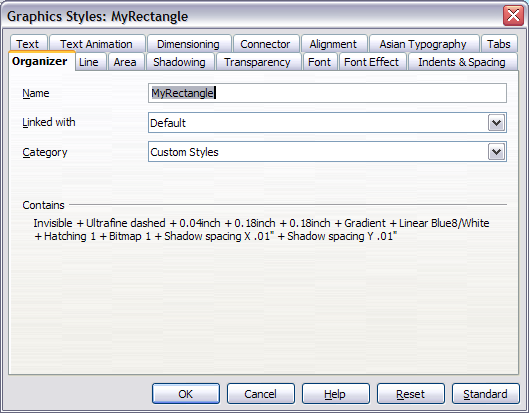Using graphics styles to format graphics
In many situations where a presentation contains only a few graphic objects, manual formatting can be an efficient way to change their appearance. However, when you want to achieve consistency in the style across the slides of your presentation (or your presentations portfolio), or simply when you want to apply the same formatting to a large number of objects, the best approach is to use graphics styles.
Graphics styles are the equivalent for graphic objects to the presentation styles for text. A graphics style groups all the formatting attributes that a graphic object could have and associates this set to a name, making them quickly reusable. If a style is modified (for example, by changing the area transparency), the changes are automatically applied to all the graphics with that style.
Using the inheritance properties of styles also achieves professional results in a short time. For example, if multiple lines change in color but are otherwise identically formatted, the best way to proceed is to define a generic style for the line and a number of hierarchically dependent styles which only differ in the line color attribute. If later you need to change the arrowhead style or the thickness of the lines, it is sufficient to change the parent style and all the other styles will change accordingly.
When creating several presentations, a library of well-defined graphics styles is an invaluable tool for speeding up the process of formatting a new presentation while achieving the desired appearance.
To create a new style, follow the procedures outlined in Chapter 2. As shown below, the dialog to create a graphics style consists of 15 pages.
- The Organizer page, which contains a summary of the style and its hierarchical position, is discussed in Chapter 2.
- The Font, Font Effects, Indents & Spacing, Alignment, Tabs and Asian typography pages, which set the properties of the text and are shared with presentation styles, are discussed in detail in Chapter 3.
- The Dimensioning page is used to set the style of dimension lines and it is not normally used in presentations. For further details refer to the Draw Guide.
- The remaining pages (Text, Text animation, Connector, Line, Area, Shadowing, and Transparency) contain the same options as the dialogs for manual formatting of the Line, Area, Text and Connectors; they are discussed in this chapter.
| In most of the cases you will not need to configure the parameters of every page; for example, to create a simple line style you will probably only use 3 of the 15 pages. |

The dialog for defining a custom graphics style.
To apply a style, select the object (or objects) and click on the style from the Styles and Formatting window. If the window is not showing, press F11, or click the Styles and Formatting icon at the left-hand end of the formatting bar, or select Format > Styles and Formatting from the menu bar. Press F11 again when the dialog is not needed, to maximize the workspace area.
| Content on this page is licensed under the Creative Common Attribution 3.0 license (CC-BY). |